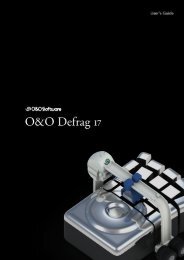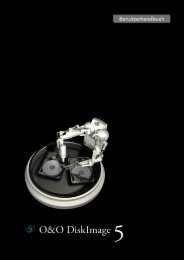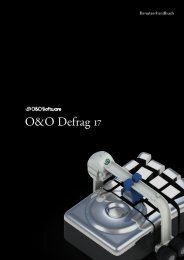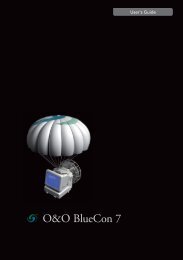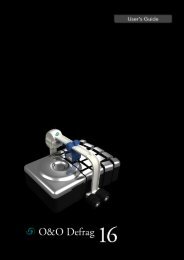Installation and System Requirements - O&O Software
Installation and System Requirements - O&O Software
Installation and System Requirements - O&O Software
You also want an ePaper? Increase the reach of your titles
YUMPU automatically turns print PDFs into web optimized ePapers that Google loves.
My computer is mainly used as a server<br />
The methods STEALTH, SPACE, COMPLETE/Access <strong>and</strong> COMPLETE/Modified are best suited<br />
for servers. Files are created, changed <strong>and</strong> deleted with great regularity on all servers, but<br />
particularly on file servers, Fragmentation therefore occurs more quickly <strong>and</strong> severely than on<br />
other computers. The COMPLETE methods organize your files in order to prevent the need<br />
for subsequent complete reorganizations – only the files that have recently been changed<br />
need to be defragmented.<br />
We recommend an initial defragmentation with COMPLETE/Modified <strong>and</strong> then the use of<br />
STEALTH or SPACE.<br />
Please bear in mind that using COMPLETE/Access, COMPLETE/Modified <strong>and</strong> COMPLETE/<br />
Name on one partition leads to much slower defragmentation runs because the files are sorted<br />
in different ways in each of these methods. Please decide on just one of the COMPLETE<br />
methods for use on your system!<br />
A large number of files are saved on my computer<br />
If you have a large number of files saved on your system, e.g., more than 500,000, STEALTH<br />
defragmentation is the best method for you. The STEALTH method avoids reading the<br />
complete file information, which under certain circumstances can be extremely time-consuming.<br />
How much free disk space is needed for defragmentation?<br />
Free disk space is a very important factor for a successful defragmentation. The less space<br />
that is available, the greater the time required for the defragmentation. This is true of all<br />
methods described here. We recommend you keep at least 5% free space available on the<br />
drive(s) you wish to defragment. This value is, however, dependent on the individual system<br />
configuration, the number of files <strong>and</strong> their size. On NTFS drives, it is particularly important<br />
to note the real free disk space. You can find this information in Drive Status after the<br />
words Free without res. MFT. The number indicated is the amount of space that is actually<br />
available for the applications such as O&O Defrag. Windows itself can also write to the MFT<br />
reserved area but for security reasons, other applications may not. This is one reason why<br />
Windows displays more space than is actually available.<br />
Continue working undisturbed while defragmenting<br />
Particularly in the case of workstations or servers that are under pressure all the time, it is<br />
important that defragmentation take place in the background without negatively affecting<br />
the day-to-day running of the system. In such situations, we recommend you use O&O ActivityGuard<br />
Pro for keeping an eye on the resource usage <strong>and</strong> automatically adjusting the<br />
burden placed on your system by O&O Defrag.<br />
Windows is also able to write in the MFT sector. Other applications, for reasons of security,<br />
are not allowed to do this. This is also the reason why Windows Explorer displays more free<br />
disk space than is actually available for the defragmentation.<br />
50 l Tips <strong>and</strong> Frequently Asked Questions<br />
User's Guide for O&O Defrag 11





